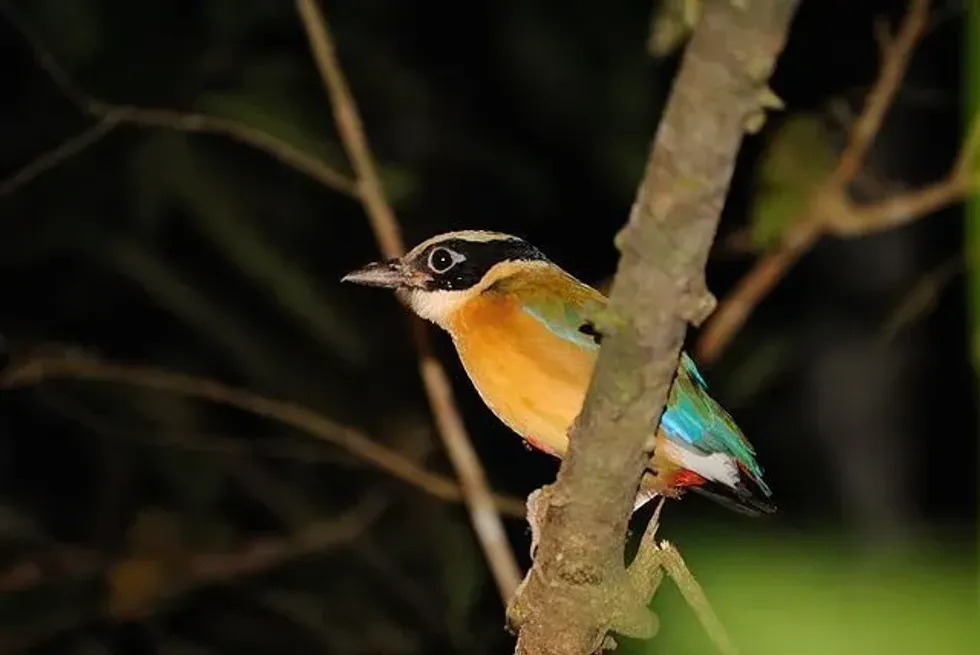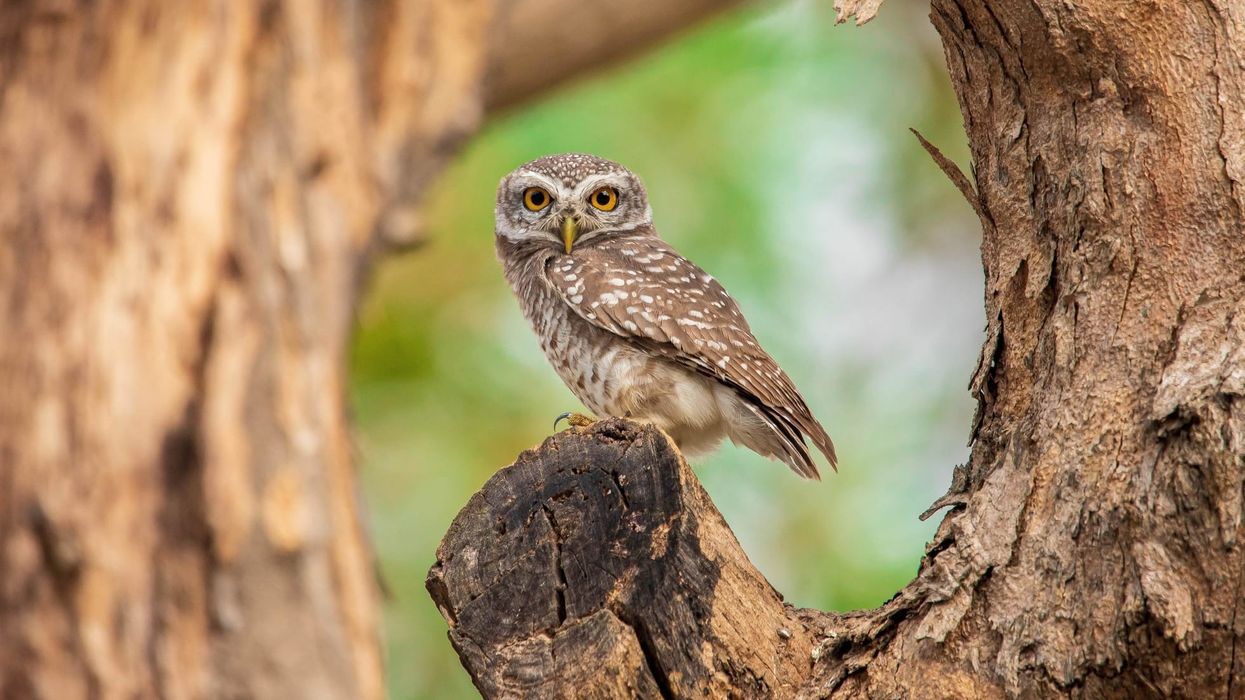Four species of pitta birds namely the fairy pitta (P. nympha), mangrove pitta (P. megarhyncha), Indian pitta (P. brachyura), and lastly, the blue-winged pitta (Pitta moluccensis) constitute a superspecies. Initially, the binomial name of the bird species, as attributed by Philipp Ludwig Statius Müller, was Turdus moluccensis.
Later it was observed that the French term 'moluccensis' (from Moluccas) was wrongly conferred by the German naturalist as the bird was actually absent from the Maluku Islands.
Ultimately, in 1816, the taxonomy of the bird was slightly altered and it was regrouped under the Pitta genus by Louis Jean Pierre Vieillot, a French ornithologist. The habitation range extends throughout Southeast Asia.
You might venture out into the forests of Malaysia to get a proper glimpse of the species but the blue-winged pitta bird is not so easy to trace!
These birds are adept at the art of camouflage. They display the blue-green parts by concealing the bright buff underparts so that the predators are unable to trace them.
Want to know more about the blue-winged pitta? Here are some of the best facts curated just for your unique taste! Also, peek into these mind-blowing facts about the pigeon and Macaw.
Blue-Winged Pitta Interesting Facts
What type of animal is a blue-winged pitta?
The blue-winged pitta (Pitta moluccensis) of the Pittidae family is a species of songbird.
What class of animal does a blue-winged pitta belong to?
Belonging to the Pitta genus, the blue-winged pittas have been classified under the class Aves.
How many blue-winged pittas are there in the world?
Although the species is abundant within its geographical habitat, the world population of Pitta moluccensis is currently projecting a decreasing trend.
Where does a blue-winged pitta live?
The blue-winged pitta has a widespread population distribution throughout the world. The geographical range extends across Southeast Asia while the bird can be sparsely located in Australia. Pittas are plentiful in places like Indonesia, China, Thailand, Myanmar, Cambodia, India, the Philippines, Vietnam, Singapore, Laos, Malaysia, and Brunei. Pitta moluccensis occurs infrequently in Taiwan, Hong Kong, and Christmas island.
What is a blue-winged pitta's habitat?
Pitta moluccensis can be traced in diverse habitats, including mangrove, scrubland, tropical and subtropical forests. The bird population also abounds in urban spaces like gardens and parks. Sometimes, the bird visits the coasts of Australia. These birds prefer to avoid the dense rainforests.
Who do blue-winged pittas live with?
This colorful bird of the Pittidae family mostly remains solitary. During the breeding period, these birds can be spotted in pairs while they also migrate in small flocks outside the breeding season.
How long does a blue-winged pitta live?
In the wilderness, the blue-winged pitta can survive for more than five years as the longest living bird was five years and seven months old. In captivity, the giant pitta (Pitta caerulea) can thrive for over twelve years, so a similar lifespan can be assumed for the blue-winged pitta.
How do they reproduce?
Pitta moluccensis is monogamous. Generally, the breeding season extends from April to August.
After copulation, these birds construct large spherical nests on the surface of the ground, placed near water or among roots of trees where they might be safely concealed from nest predators like snakes. The nest is typically untidy, crafted out of roots, mosses, leaves, twigs, and other fibrous materials extracted from the forest cover.
Four to five cream-white eggs spotted with purple are laid by females from the beginning of May till July. Incubation is served by both partners for about 15 - 17 days.
What is their conservation status?
The adult population blue-winged pitta (Pitta moluccensis) has not been quantified but since the species is quite common within its habitat range, the International Union for Conservation of Nature (IUCN) Red List has attributed the Least Concern status to the bird.
Blue-Winged Pitta Fun Facts
What do blue-winged pittas look like?
With a moderate body size, the blue-winged pitta possesses dark green upperparts, turquoise-blue rump, and buff underparts. The tail is short and black that turns blue-green at the edges while the chin is white and shoulders are shaded green.
Both the bill and head are black. The supercilium on its head is hued with buff. Over each eye, there's a buff strip.
As the name goes, the bird exhibits radiant blue wings. The iris is brown and the legs are lilac to pink. Males and females look alike but juveniles project a paler coloration and have a red-tipped bill.
However, the plumage of Pitta moluccensis is not predominantly blue as that of the blue pitta (Hydrornis cyaneus). This description can be used to spot this bird in the wild.

How cute are they?
Pittas are lustrous birds varying from small to medium size. One of the most colorful bird species, the glamorous Pitta moluccensis never fails to grab eyeballs. You can't help but fall for the captivating charm of these adorable little chicks!
How do they communicate?
Like any other bird species, Pitta moluccensis interacts via innumerable calls, sounds, and gestures. The calls are distinct and loud. A repetitive disyllabic 'taewu-taewu' or 'taelaew-taelaew' and jarring 'skyeew' sounds have been recorded.
How big is a blue-winged pitta?
Pitta moluccensis measures approximately 7-7.9 in (18-20 cm) in length. The bird is quite small when compared with the giant pitta that can grow to a maximum length of 11 in (29 cm). However, these birds are more than three times larger than the bee hummingbirds measuring around 2.1-2.4 in (5.5-6.1 cm).
How fast can a blue-winged pitta fly?
Accurate details about the speed range of Pitta moluccensis are lacking. However, pittas, in general, can achieve a speed of 10-20 mph (16-32 kph).
Since the species belongs to the Pittidae family, it can be inferred that these birds have imbibed the flight speed common to their family. Nevertheless, these birds are not too enthusiastic fliers. The upper elevation limit of these birds has been recorded at 5,905.5 ft (1,800 m).
How much does a blue-winged pitta weigh?
The average weight of these birds falls in the range of 0.11-0.32 lb (54-146 g).
What are the male and female names of the species?
Males and females of any bird species are referred to as cocks and hens respectively.
What would you call a baby blue-winged pitta?
A baby blue-winged pitta can be called a chick in short while it can also be regarded as a hatchling or nestling.
What do they eat?
Pitta moluccensis indulges in an insectivorous diet comprising a variety of insect species as well as the larvae. These birds are known to feed on scarab beetles, coreid bugs, fireflies, hornets, and grasshoppers.
They also feast on earthworms, snails, spiders, and crustaceans such as crabs and shrimps. These birds can be spotted foraging on the ground or hunting from a perch close to the ground.
Are they dangerous?
Pitta birds are not at all dangerous. Quite contrarily, the species is threatened by human activities. In Thailand, Pitta moluccensis has been hunted down for their flesh. They're also preyed upon by predatory birds such as falcons.
Would they make a good pet?
Pittas are not as famous as the parrot, budgerigar, or pigeon. Although these wild birds are a major attraction in zoos, they haven't been tamed. In aviaries, they have adjusted well with other birds without any hint of aggression. However, their behavior as a pet cannot be mentioned.
Did you know...
In Spanish, the species is popular by the name pita aliazul while the French call it brève à ailes bleues.
In Singapore, Pitta moluccensis can be spotted in the Bukit Timah Nature Reserve whereas, in Thailand, the Kaeng Krachan and Khao Yai National Parks boast of the species. Thailand is also replete with other pitta species like the Garnet pitta, Malayan banded pitta, blue pitta, and several others.
They are not endemic to any place. They are migrant birds, however.
Do blue-winged pittas migrate?
Pitta moluccensis isa fully migrant bird. These birds flock together to migrate mostly outside the breeding period. The Sumatra islands, Malaysia, and Borneo are their favorite migratory destinations for the winter.
How many species of pitta are there?
Classified solely under the Pitta genus, 16 pitta species have been identified to date. In India, eight distinct pitta species include Pitta moluccensis, Pitta megarhyncha, Hydrornis phayrei, Pitta sordida, Pitta brachyura, Hydrornis cyaneus, Hydrornis nipalensis, and Pitta nympha.
Here at Kidadl, we have carefully created lots of interesting family-friendly animal facts for everyone to discover! For more relatable content, check out these elegant crested tinamou facts and Franklin Gull facts pages.
You can even occupy yourself at home by coloring in one of our free printable Parts The Bird Coloring Pages.
The main image is owned by diego_cue.
The second image is owned by JJ Harrison.









